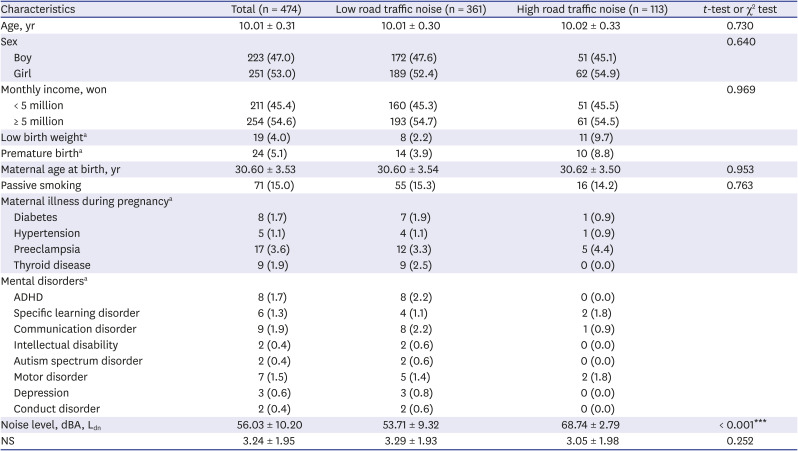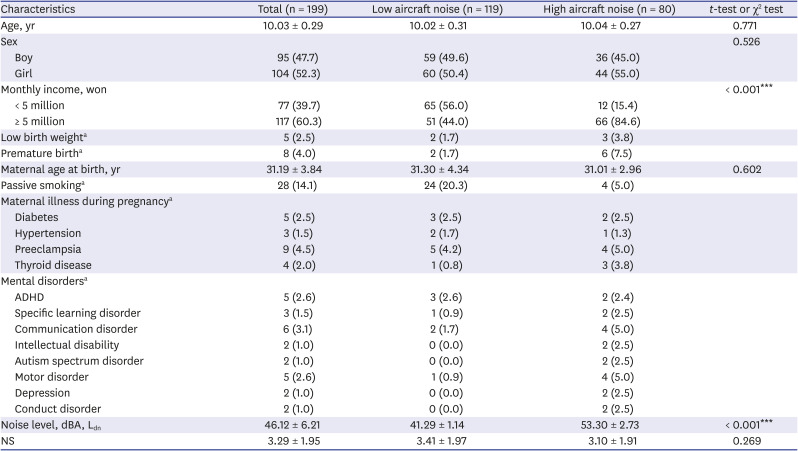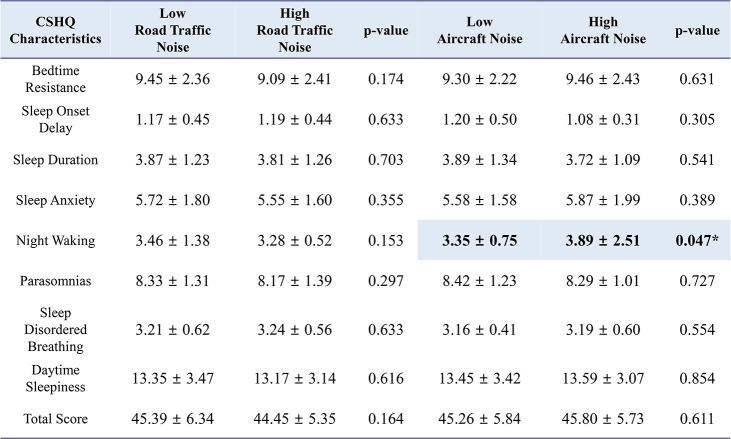2. Basner M, Babisch W, Davis A, Brink M, Clark C, Janssen S, et al. Auditory and non-auditory effects of noise on health. Lancet. 2014; 383(9925):1325–1332. PMID:
24183105.

3. Basner M, Brink M, Bristow A, de Kluizenaar Y, Finegold L, Hong J, et al. ICBEN review of research on the biological effects of noise 2011-2014. Noise Health. 2015; 17(75):57–82. PMID:
25774609.

4. Stansfeld SA, Berglund B, Clark C, Lopez-Barrio I, Fischer P, Ohrström E, et al. Aircraft and road traffic noise and children's cognition and health: a cross-national study. Lancet. 2005; 365(9475):1942–1949. PMID:
15936421.

5. Recio A, Linares C, Banegas JR, Díaz J. Road traffic noise effects on cardiovascular, respiratory, and metabolic health: an integrative model of biological mechanisms. Environ Res. 2016; 146:359–370. PMID:
26803214.

6. Floud S, Blangiardo M, Clark C, de Hoogh K, Babisch W, Houthuijs D, et al. Exposure to aircraft and road traffic noise and associations with heart disease and stroke in six European countries: a cross-sectional study. Environ Health. 2013; 12(1):89. PMID:
24131577.

7. Hume KI, Brink M, Basner M. Effects of environmental noise on sleep. Noise Health. 2012; 14(61):297–302. PMID:
23257581.

8. Cohen S, Krantz DS, Evans GW, Stokols D. Cardiovascular and behavioral effects of community noise. Am Sci. 1981; 69(5):528–535. PMID:
7294497.
9. Stansfeld S, Haines M, Brown B. Noise and health in the urban environment. Rev Environ Health. 2000; 15(1-2):43–82. PMID:
10939085.

10. Kim SD. A study of effects of noise on the mental health of inhabitants in urban setting. J Korean Neuropsychiatr Assoc. 1975; 14(1):57–59.
11. Ristovska G, Lekaviciute J. Environmental noise and sleep disturbance: research in Central, Eastern and South-Eastern Europe and Newly Independent States. Noise Health. 2013; 15(62):6–11. PMID:
23412575.

12. Tarnopolsky A, Watkins G, Hand DJ. Aircraft noise and mental health: I. Prevalence of individual symptoms. Psychol Med. 1980; 10(4):683–698. PMID:
7208727.

13. Watkins G, Tarnopolsky A, Jenkins LM. Aircraft noise and mental health: II. Use of medicines and health care services. Psychol Med. 1981; 11(1):155–168. PMID:
7208739.

14. Abey-Wickrama I, A'Brook MF, Gattoni FE, Herridge CF. Mental-hospital admissions and aircraft noise. Lancet. 1969; 2(7633):1275–1277. PMID:
4187981.

15. Rey Gozalo G, Barrigón Morillas JM, Montes González D, Atanasio Moraga P. Relationships among satisfaction, noise perception, and use of urban green spaces. Sci Total Environ. 2018; 624:438–450. PMID:
29268216.

16. Dzhambov AM, Dimitrova DD. Urban green spaces' effectiveness as a psychological buffer for the negative health impact of noise pollution: a systematic review. Noise Health. 2014; 16(70):157–165. PMID:
24953881.

17. Hjortebjerg D, Andersen AM, Christensen JS, Ketzel M, Raaschou-Nielsen O, Sunyer J, et al. Exposure to road traffic noise and behavioral problems in 7-year-old children: a cohort study. Environ Health Perspect. 2016; 124(2):228–234. PMID:
26126294.

18. Dreger S, Meyer N, Fromme H, Bolte G. Study group of the GME cohort. Environmental noise and incident mental health problems: a prospective cohort study among school children in Germany. Environ Res. 2015; 143(Pt A):49–54. PMID:
26433757.

19. In : Kweon K, Park J, Chung S, Kim HW, editors. Effects of environmental noise on the mental health of children and adolescents. The 57th Fall Conference of the Korean Society of Occupational and Environmental Medicine 2016; 2016 Nov 3-5; Jeongseon, Korea. Seoul: Korean Society of Occupational & Environmental Medicine;2016. 11. p. 135.
20. Tiesler CM, Birk M, Thiering E, Kohlböck G, Koletzko S, Bauer CP, et al. Exposure to road traffic noise and children's behavioural problems and sleep disturbance: results from the GINIplus and LISAplus studies. Environ Res. 2013; 123:1–8. PMID:
23498846.

21. Malik M, Bigger JT, Camm AJ, Kleiger RE, Malliani A, Moss AJ, et al. Heart rate variability. Standards of measurement, physiological interpretation, and clinical use. Eur Heart J. 1996; 17(3):354–381. PMID:
8737210.

22. Kop WJ, Stein PK, Tracy RP, Barzilay JI, Schulz R, Gottdiener JS. Autonomic nervous system dysfunction and inflammation contribute to the increased cardiovascular mortality risk associated with depression. Psychosom Med. 2010; 72(7):626–635. PMID:
20639389.

23. Park J, Chung S, Lee J, Sung JH, Cho SW, Sim CS. Noise sensitivity, rather than noise level, predicts the non-auditory effects of noise in community samples: a population-based survey. BMC Public Health. 2017; 17(1):315. PMID:
28403870.

24. Nordin S, Ljungberg JK, Claeson AS, Neely G. Stress and odor sensitivity in persons with noise sensitivity. Noise Health. 2013; 15(64):173–177. PMID:
23689299.

25. Li K, Rüdiger H, Ziemssen T. Spectral analysis of heart rate variability: time window matters. Front Neurol. 2019; 10:545. PMID:
31191437.

26. Shaffer F, Ginsberg JP. An overview of heart rate variability metrics and norms. Front Public Health. 2017; 5:258. PMID:
29034226.

27. Tucker P, Pfefferbaum B, Jeon-Slaughter H, Khan Q, Garton T. Emotional stress and heart rate variability measures associated with cardiovascular risk in relocated Katrina survivors. Psychosom Med. 2012; 74(2):160–168. PMID:
22286851.

28. Michels N, Sioen I, Clays E, De Buyzere M, Ahrens W, Huybrechts I, et al. Children’s heart rate variability as stress indicator: association with reported stress and cortisol. Biol Psychol. 2013; 94(2):433–440. PMID:
24007813.

30. Owens JA, Spirito A, McGuinn M. The children's sleep habits questionnaire (CSHQ): psychometric properties of a survey instrument for school-aged children. Sleep. 2000; 23(8):1043–1051. PMID:
11145319.

31. Peltola MA. Role of editing of R-R intervals in the analysis of heart rate variability. Front Physiol. 2012; 3:148. PMID:
22654764.

32. Lim J, Kweon K, Kim HW, Cho SW, Park J, Sim CS. Negative impact of noise and noise sensitivity on mental health in childhood. Noise Health. 2018; 20(96):199–211. PMID:
30516173.
33. Pérez-González D, Malmierca MS. Adaptation in the auditory system: an overview. Front Integr Nuerosci. 2014; 8:19.

34. Marrufo-Pérez MI, Sturla-Carreto DDP, Eustaquio-Martín A, Lopez-Poveda EA. Adaptation to noise in human speech recognition depends on noise-level statistics and fast dynamic-range compression. J Neurosci. 2020; 40(34):6613–6623. PMID:
32680938.

35. Baranzini A, Schaerer C, Thalmann P. Using measured instead of perceived noise in hedonic models. Transp Res Part D Transp Environ. 2010; 15(8):473–482.

36. Basner M, Witte M, McGuire S. Aircraft noise effects on sleep-results of a pilot study near Philadelphia international airport. Int J Environ Res Public Health. 2019; 16(17):3178.

37. Haines MM, Stansfeld SA, Job RF, Berglund B, Head J. Chronic aircraft noise exposure, stress responses, mental health and cognitive performance in school children. Psychol Med. 2001; 31(2):265–277. PMID:
11232914.

38. Bullinger M, Hygge S, Evans GW, Meis M, von Mackensen S. The psychological cost of aircraft noise for children. Zentralbl Hyg Umweltmed. 1999; 202(2-4):127–138. PMID:
10507123.

39. Brink M, Schäffer B, Vienneau D, Foraster M, Pieren R, Eze IC, et al. A survey on exposure-response relationships for road, rail, and aircraft noise annoyance: Differences between continuous and intermittent noise. Environ Int. 2019; 125:277–290. PMID:
30731377.

40. Jarup L, Dudley ML, Babisch W, Houthuijs D, Swart W, Pershagen G, et al. Hypertension and exposure to noise near airports (HYENA): study design and noise exposure assessment. Environ Health Perspect. 2005; 113(11):1473–1478. PMID:
16263498.

41. Brink M, Schäffer B, Vienneau D, Pieren R, Foraster M, Eze IC, et al. Self-reported sleep disturbance from road, rail and aircraft noise: exposure-response relationships and effect modifiers in the SiRENE study. Int J Environ Res Public Health. 2019; 16(21):4186.

42. Douglas O, Murphy E. Source-based subjective responses to sleep disturbance from transportation noise. Environ Int. 2016; 92-93:450–456. PMID:
27164553.

43. Sim CS, Sung JH, Cheon SH, Lee JM, Lee JW, Lee J. The effects of different noise types on heart rate variability in men. Yonsei Med J. 2015; 56(1):235–243. PMID:
25510770.

44. Kraus U, Schneider A, Breitner S, Hampel R, Rückerl R, Pitz M, et al. Individual daytime noise exposure during routine activities and heart rate variability in adults: a repeated measures study. Environ Health Perspect. 2013; 121(5):607–612. PMID:
23512292.
















 PDF
PDF Citation
Citation Print
Print




 XML Download
XML Download